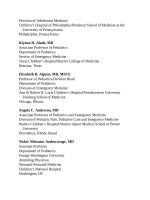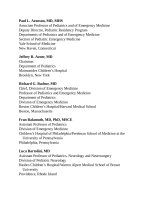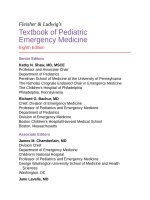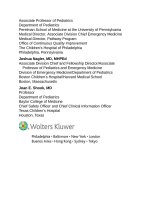Pediatric emergency medicine trisk 1456 1456
Bạn đang xem bản rút gọn của tài liệu. Xem và tải ngay bản đầy đủ của tài liệu tại đây (74.84 KB, 1 trang )
Certain arrhythmias may cause an infant to appear ill. Supraventricular
tachycardia (SVT) often presents with findings similar to those of a septic infant.
This arrhythmia may be idiopathic (50%), associated with CHD (20%), or related
to drugs, fever, or infection (20%). Young infants with SVT often go
unrecognized initially as they have only poor feeding, fussiness, and some rapid
breathing. They eventually develop congestive heart failure as the condition goes
untreated and may present with shock. Fever can precipitate the arrhythmia,
confusing the condition with sepsis, though the cardiac examination will reveal
such extreme tachycardia in the infant that the heart rate cannot be counted, often
exceeding 250 to 300 beats per minute. An ECG will show regular atrial and
ventricular beats with 1:1 conduction, although P waves appear different than
sinus P waves and may be difficult to see as they are often buried in the T waves.
A chest radiograph may show cardiomegaly and pulmonary congestion.
Additional cardiac pathologies to consider include pericarditis and
myocarditis. Pericarditis may be caused by bacterial organisms such as
Staphylococcus aureus; myocarditis usually results from viral infections such as
coxsackievirus B. These babies will appear critically ill with fever and grunting
respirations, but a complete physical examination may help the physician
distinguish these conditions from sepsis if signs of heart failure or unexplained
tachycardia are present. Pericarditis may produce neck vein distention, distant
heart sounds, and a friction rub if a significant pericardial effusion exists.
Physical findings with myocarditis may include muffled heart sounds (due to
ventricular dilatation), gallop rhythm, hepatosplenomegaly, and weak distal
pulses with poor perfusion. A chest radiograph in a patient with pericarditis will
show cardiomegaly and a suggestion of effusion. The ECG will show generalized
T-wave inversion and low-voltage QRS complexes if pericardial fluid is present,
and ST-T–wave abnormalities may be seen. The echocardiogram will confirm the
presence or absence of a pericardial effusion and poor ventricular function in the
case of viral myocarditis. Cardiac magnetic resonance will show inflammation,
edema, and scarring. Troponins can detect cardiac injury, and natriuretic peptides
can help differentiate cardiac from respiratory symptoms, and though nonspecific
may help in leading to a diagnosis of myocarditis.
Kawasaki disease with associated coronary artery aneurysms is very rare in
young infants but may present with cyanosis and shock. Usually, history reveals
prolonged and unexplained fever, rash, and mucous membrane inflammation.
Neonates with Kawasaki disease often have an atypical presentation and the
classic features found in older infants and children (e.g., swelling of hands and
feet, cracked red lips, scleral erythema) may be absent in young babies. A CBC









